Impressions: Aku no Hana (Flowers of Evil)
Episodes 2-5
Episode 2
Ink: A fter an episode almost entirely devoted to establishing atmosphere and introducing the main character, Aku no Hana starts to build its momentum. This episode covers much more material than the first, exposing Kasuga’s inner conflict and compounding it by revealing just how unsettling Nakamura’s smile can be. Consequently, there’s a noticeable effect on the depth of Kasuga’s interactions with friends and family, but this does not detract from the focus on his introspective moments that truly distinguish this anime. All of this offers a reprieve from the tack taken by most series focused on high school students; with this episode, Aku no Hana asserts that it is not just about a protagonist’s unrequited love for the cutest girl in the class — there is, in fact, something much more horrifying.
fter an episode almost entirely devoted to establishing atmosphere and introducing the main character, Aku no Hana starts to build its momentum. This episode covers much more material than the first, exposing Kasuga’s inner conflict and compounding it by revealing just how unsettling Nakamura’s smile can be. Consequently, there’s a noticeable effect on the depth of Kasuga’s interactions with friends and family, but this does not detract from the focus on his introspective moments that truly distinguish this anime. All of this offers a reprieve from the tack taken by most series focused on high school students; with this episode, Aku no Hana asserts that it is not just about a protagonist’s unrequited love for the cutest girl in the class — there is, in fact, something much more horrifying.
 While many scenes still employ shot-for-shot manga panel reproductions, there are images with slight deviations — the line of sight regarding Kasuga, his copy of
While many scenes still employ shot-for-shot manga panel reproductions, there are images with slight deviations — the line of sight regarding Kasuga, his copy of
, and Saeki’s bag; the lack of overemphasized blushing; and the non-transparent bag below Kasuga’s desk — that seem most pertinent. Additions such as Kasuga’s initial slow, defeated drop to his knees; its reprise; and prayer-like invocations of Les Fleurs de Mal excerpts increase the depth of shame that now feels only alluded to by the manga and offer myriad talking points. But all is not doom. Somewhat surprising are the interjections of humor — Kasuga’s flight and the suspicion sight gag, which manage to add a bit of welcome levity without completely distracting from the established atmosphere of anxiety and isolation.
David:  I don’t know, Ink, scenes like the bike scene have me worried for how some of the upcoming pivotal moments will end up being adapted. For one, it reveals a serious disconnect between the actor in real life and his voice, where the actor on the screen has his features and gestures blotted out by the nature of the rotoscoping technique, severing the voice from its source. What we end up with is a human-shaped mass failing to wobble its way out of the uncanny valley to the point where the rotoscoping is no longer just weird and mysterious, it’s actually detracting from the quality of the acting, keeping the technique from reaching the absolute minimum as an animation where I can take it seriously.
I don’t know, Ink, scenes like the bike scene have me worried for how some of the upcoming pivotal moments will end up being adapted. For one, it reveals a serious disconnect between the actor in real life and his voice, where the actor on the screen has his features and gestures blotted out by the nature of the rotoscoping technique, severing the voice from its source. What we end up with is a human-shaped mass failing to wobble its way out of the uncanny valley to the point where the rotoscoping is no longer just weird and mysterious, it’s actually detracting from the quality of the acting, keeping the technique from reaching the absolute minimum as an animation where I can take it seriously.
So I won’t take it seriously. The Flowers of Evil is a fine manga, but it’s not translating into a great show. At least, not as far as Episode 2 goes. As it stands, it’s not succeeding in its attempts to allegedly break the conventions set by modern anime and has me thinking perhaps they should have just stayed with a live-action adaptation.
Episode 3
David:  It’s Episode 3 and we’re still going on about the gym uniform. Kasuga can’t seem to get rid of the thing and the show doesn’t seem to be in any rush to pick up the pace to get past it either. The show is filled with dead air that, while it can be used for dramatic effect, has me exasperated waiting for the really wild moments of Flowers. I complained about Kasuga’s acting before, and while watching a spineless and bumbling protagonist is never enjoyable, it is what’s expected of the character. That said, I am a little bummed that Nakamura’s performance is . . . not great, but it’s not bad either. The first episode established a mood that unfortunately I have not felt this Nakamura has lived up to. She’s not so menacing anymore, she’s just really weird. Sure, Nakamura’s strange in the manga, but she also has a dangerous side to her that isn’t coming through in the show. Instead, the direction is already diving into the inevitable sexual tension between Nakamura and Kasuga before even getting around to Kasuga’s relationship with Saeki, which kind of works better than a lot of other things the show has tried to do but is still getting ahead of itself.
It’s Episode 3 and we’re still going on about the gym uniform. Kasuga can’t seem to get rid of the thing and the show doesn’t seem to be in any rush to pick up the pace to get past it either. The show is filled with dead air that, while it can be used for dramatic effect, has me exasperated waiting for the really wild moments of Flowers. I complained about Kasuga’s acting before, and while watching a spineless and bumbling protagonist is never enjoyable, it is what’s expected of the character. That said, I am a little bummed that Nakamura’s performance is . . . not great, but it’s not bad either. The first episode established a mood that unfortunately I have not felt this Nakamura has lived up to. She’s not so menacing anymore, she’s just really weird. Sure, Nakamura’s strange in the manga, but she also has a dangerous side to her that isn’t coming through in the show. Instead, the direction is already diving into the inevitable sexual tension between Nakamura and Kasuga before even getting around to Kasuga’s relationship with Saeki, which kind of works better than a lot of other things the show has tried to do but is still getting ahead of itself.
 Perhaps I’m guilty of assigning specific voices and mannerisms to these characters, but I can’t help but to disagree with the way a lot of the content is being adapted. The minor characters are excellent, so I can’t seem to figure out how to salvage the leads short of projecting my own ideas onto the show with enough determination to warp the reality of the situation.
Perhaps I’m guilty of assigning specific voices and mannerisms to these characters, but I can’t help but to disagree with the way a lot of the content is being adapted. The minor characters are excellent, so I can’t seem to figure out how to salvage the leads short of projecting my own ideas onto the show with enough determination to warp the reality of the situation.
Ink:  As wonderful as Mariya Ise is in portraying a nigh-biopolar tsundere (if only a bit too bubbly during the more manic moments), I’ll side with David in that she doesn’t quite carry the same air of malicious intent as her manga counterpart. Her efforts in that area feel betrayed at times, as David mentioned, when her heated or rapid speech is misrepresented by the slowness of the rotoscoping. While immediately unpalatable, this effect evokes a disconnect that David mentioned earlier in disgust but which I find quite impressive if taken to represent the difference between Kasuga’s consternation and the actual pace of the moment. In short, everything appears slow and out of whack as if some nightmarish scenario is taking place . . . because it is. When Shinichiroh Ueda erupts as Kasuga, the jerkier movements observed through a shaky camera seem better matched through more careful animation (though still anywhere near perfect, and I’ll get to that later), revealing a reactionary refocusing.
As wonderful as Mariya Ise is in portraying a nigh-biopolar tsundere (if only a bit too bubbly during the more manic moments), I’ll side with David in that she doesn’t quite carry the same air of malicious intent as her manga counterpart. Her efforts in that area feel betrayed at times, as David mentioned, when her heated or rapid speech is misrepresented by the slowness of the rotoscoping. While immediately unpalatable, this effect evokes a disconnect that David mentioned earlier in disgust but which I find quite impressive if taken to represent the difference between Kasuga’s consternation and the actual pace of the moment. In short, everything appears slow and out of whack as if some nightmarish scenario is taking place . . . because it is. When Shinichiroh Ueda erupts as Kasuga, the jerkier movements observed through a shaky camera seem better matched through more careful animation (though still anywhere near perfect, and I’ll get to that later), revealing a reactionary refocusing.
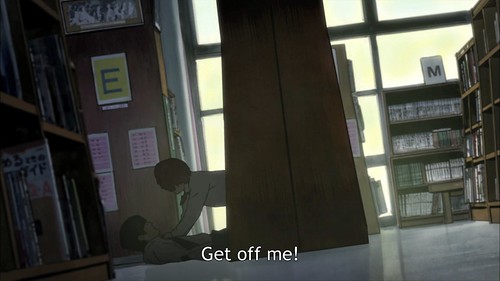 Yes, the pacing is slow, and it would be infuriatingly so if it didn’t work so well in the sense of drama building David spoke of or serve as contrast for moments like the changing scene in the library in this episode. That scene. THAT scene. Oh, man, that scene. As surprised as I was that they even included it in such detail, I was more impressed with the tact and power behind its execution. Viewers will solidly feel Nakamura’s sadistic rapture and Kasuga’s bewildered helplessness. Most of all, however, viewers will feel the rush only made possible by such action cutting through the “dead air” set in place by the preceding scenes. And it’s this sense of exhilaration that begins to sow the seeds for the cultivation of the flower of evil within Kasuga.
Yes, the pacing is slow, and it would be infuriatingly so if it didn’t work so well in the sense of drama building David spoke of or serve as contrast for moments like the changing scene in the library in this episode. That scene. THAT scene. Oh, man, that scene. As surprised as I was that they even included it in such detail, I was more impressed with the tact and power behind its execution. Viewers will solidly feel Nakamura’s sadistic rapture and Kasuga’s bewildered helplessness. Most of all, however, viewers will feel the rush only made possible by such action cutting through the “dead air” set in place by the preceding scenes. And it’s this sense of exhilaration that begins to sow the seeds for the cultivation of the flower of evil within Kasuga.
Episode 4
Ink: 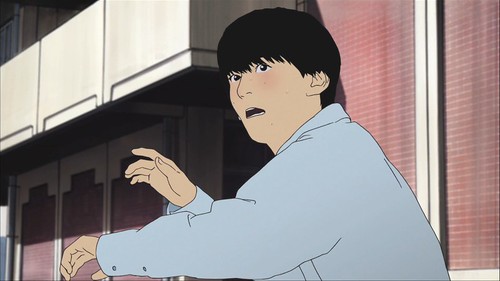 Even though Kasuga’s consciously befuddled as to why he stood up to his classmates accusing Nakamura of stealing, viewers have a clue. Reality’s mask, however, encourages Kasuga’s white knight mindset after an interchange with Saeki, following which the world is naught but pop melodies and rainbow-crapping koalas . . . at least for a little bit. Nakamura stumbles upon Kasuga’s happiness and keeps him guessing as to the true, multilayered intent behind her all too eager encouragement until almost the very last moments of this episode.
Even though Kasuga’s consciously befuddled as to why he stood up to his classmates accusing Nakamura of stealing, viewers have a clue. Reality’s mask, however, encourages Kasuga’s white knight mindset after an interchange with Saeki, following which the world is naught but pop melodies and rainbow-crapping koalas . . . at least for a little bit. Nakamura stumbles upon Kasuga’s happiness and keeps him guessing as to the true, multilayered intent behind her all too eager encouragement until almost the very last moments of this episode.
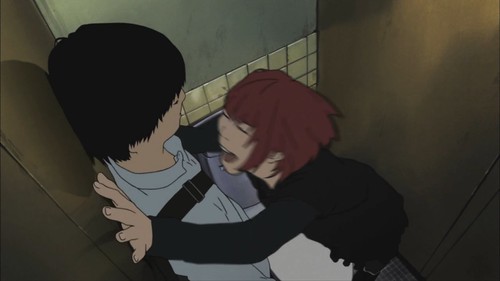 After being slapped in the face by Kasuga’s inattentive daydreaming, Nakamura’s machinations step things up a notch in order to expose everything under his “mask.” The resulting sense of horror is foreshadowed by the creepiness brought on by the slow animation but amplified when it stops altogether, such as when Kasuga sits at his desk and overhears his classmates’ still-lipped murmurs rumors about himself and Nakamura. This is, of course, not something entirely out of the equation; Kasuga makes the same assumption during the bathroom scene, which consequently and effectively uses the building of ambient sounds, slightly shaky camera, and Mariya Ise’s dead-on laughter and screaming to send shivers down spines.
After being slapped in the face by Kasuga’s inattentive daydreaming, Nakamura’s machinations step things up a notch in order to expose everything under his “mask.” The resulting sense of horror is foreshadowed by the creepiness brought on by the slow animation but amplified when it stops altogether, such as when Kasuga sits at his desk and overhears his classmates’ still-lipped murmurs rumors about himself and Nakamura. This is, of course, not something entirely out of the equation; Kasuga makes the same assumption during the bathroom scene, which consequently and effectively uses the building of ambient sounds, slightly shaky camera, and Mariya Ise’s dead-on laughter and screaming to send shivers down spines.
David:  Being the merciful person that I am, I’ve been making a case of looking for more things that work well in Flowers as opposed to things that don’t. Kasuga’s still a punk and Nakamura hasn’t done anything interesting yet, but for some inexplicable reason, Saeki, the least interesting corner of this triangle of misfits, is the best-realized character. I’ve always thought of Yoko Hikasa as an excellent voice actress who deserves more serious roles, and while I wish it would have been in something other than this interpretation of The Flowers of Evil, it’s refreshing to hear her voice a “real” character. It helps that the gestures and mannerisms of the live actress playing Saeki match very closely with Yoko Hikasa’s delivery of her lines. For once, there’s a real connection between the animated character and the vocal performance that isn’t broken up by the rotoscoping.
Being the merciful person that I am, I’ve been making a case of looking for more things that work well in Flowers as opposed to things that don’t. Kasuga’s still a punk and Nakamura hasn’t done anything interesting yet, but for some inexplicable reason, Saeki, the least interesting corner of this triangle of misfits, is the best-realized character. I’ve always thought of Yoko Hikasa as an excellent voice actress who deserves more serious roles, and while I wish it would have been in something other than this interpretation of The Flowers of Evil, it’s refreshing to hear her voice a “real” character. It helps that the gestures and mannerisms of the live actress playing Saeki match very closely with Yoko Hikasa’s delivery of her lines. For once, there’s a real connection between the animated character and the vocal performance that isn’t broken up by the rotoscoping.
Episode 5
David: 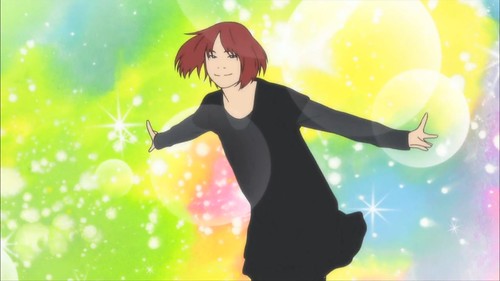 I was worried when I saw a .gif of Nakamura running through rainbow sparkles and bubbles before watching the episode and those worries were completely founded. It’s not like the direction is entirely incompetent; the studio has been following the manga close to the letter and has some good ideas about building atmosphere, but then they bungle their own designs by introducing some of the goofiest visual effects into a story grounded in reality. We move through Kasuga’s date with Saeki without much incident, save those rainbows, but the blooper reel-style replay on Kasuga’s impromptu shower was the worst — missing the feel of the manga by a mile.
I was worried when I saw a .gif of Nakamura running through rainbow sparkles and bubbles before watching the episode and those worries were completely founded. It’s not like the direction is entirely incompetent; the studio has been following the manga close to the letter and has some good ideas about building atmosphere, but then they bungle their own designs by introducing some of the goofiest visual effects into a story grounded in reality. We move through Kasuga’s date with Saeki without much incident, save those rainbows, but the blooper reel-style replay on Kasuga’s impromptu shower was the worst — missing the feel of the manga by a mile.
For what it’s worth, Flowers has been great at surprising me every week with some incredibly audacious thing that rarely turns out well in terms of its creative direction. In that regard, I almost look forward to the next episode each week. However, at this stage, I have little faith that my favorite scenes from the manga will be executed in a way that isn’t completely offensive to my tastes.
Ink:  Aku no Hana finally exemplifies how its form follows function. “I’m going to peel it all off. All the skin you’re hiding behind,” is the manga’s translation of Nakamura’s line from the previous chapter (“strip” in the flashback), either of which is much stronger than the anime’s cliché “I’ll expose everything under that mask of yours,” but both carry the same implication: breaking through the lie of the everyday lived by a person pretending to be like those who surround him. How’s this apply to rotoscoping? On his date with Saeki, Kasuga dresses in layers according to Nakamura’s demand; regular clothes worn over a fetishized prize represents normality hiding perversion, which parallels how the awkward animation layered over live action seems an ugly, unnatural, and uncomfortable mask. This notion is furthered via Kasuga’s comment of how “The really scary part is inside” when explaining his favorite book, Les Fleurs du Mal, to Saeki in a bookstore after she comments on how off-putting the cover is.
Aku no Hana finally exemplifies how its form follows function. “I’m going to peel it all off. All the skin you’re hiding behind,” is the manga’s translation of Nakamura’s line from the previous chapter (“strip” in the flashback), either of which is much stronger than the anime’s cliché “I’ll expose everything under that mask of yours,” but both carry the same implication: breaking through the lie of the everyday lived by a person pretending to be like those who surround him. How’s this apply to rotoscoping? On his date with Saeki, Kasuga dresses in layers according to Nakamura’s demand; regular clothes worn over a fetishized prize represents normality hiding perversion, which parallels how the awkward animation layered over live action seems an ugly, unnatural, and uncomfortable mask. This notion is furthered via Kasuga’s comment of how “The really scary part is inside” when explaining his favorite book, Les Fleurs du Mal, to Saeki in a bookstore after she comments on how off-putting the cover is.
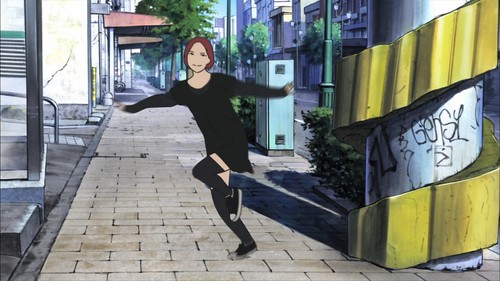 However, I have to agree with David in that breaking from illustrating reality to coloring in Kasuga’s imagination comes off as silly. Nakamura’s giddy flitting from one side of the street to the other while stalking the couple’s first date is fitting enough, but lingering on the manga’s single panel of 70’s psychedelia hurts the anime by detracting too much from the building tension; it makes a joke of the chuckle. Other little tidbits I didn’t much care for include the repeated use of transparency to remind viewers of what Kasuga is wearing, when Nakumara’s actions near the end provide a natural excuse for such exposure; the introduction and overuse of over-emphasized blushing; and the gratuitous takes of Nakamura’s dump on Kasuga, which (everything David said) detracts from the true shock of the moment.
However, I have to agree with David in that breaking from illustrating reality to coloring in Kasuga’s imagination comes off as silly. Nakamura’s giddy flitting from one side of the street to the other while stalking the couple’s first date is fitting enough, but lingering on the manga’s single panel of 70’s psychedelia hurts the anime by detracting too much from the building tension; it makes a joke of the chuckle. Other little tidbits I didn’t much care for include the repeated use of transparency to remind viewers of what Kasuga is wearing, when Nakumara’s actions near the end provide a natural excuse for such exposure; the introduction and overuse of over-emphasized blushing; and the gratuitous takes of Nakamura’s dump on Kasuga, which (everything David said) detracts from the true shock of the moment.
Flowers of Evil is now streaming on Crunchyroll.
